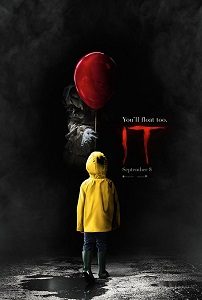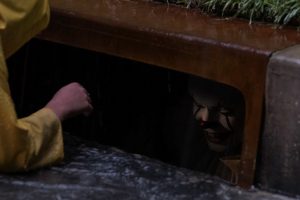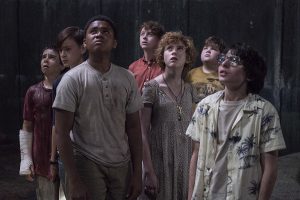 The most enduringly memorable elements of Stephen King’s most enduringly memorable novel involve seven pre-teen outcasts uniting to battle a shape shifting creature they collectively refer to as It. Each child possesses a perceived weakness, handicap, or social deficiency that ostracizes them from his or her peers, and yet these character traits are what ultimately brings them together as a greater whole. The monster they’re battling feeds upon the fertile imaginations of It’s prey, conjuring their worst fears to, in effect, “salt the meat”; but in the end, those same imaginations, coupled with the very stigma that has rendered each a so-called Loser, becomes the quasi-supernatural arsenal the children use to defeat It. The kid with the stutter uses a prescribed vocal exercise as a spell of binding; the boy who has been rendered a hypochondriac by his possessive mother turns his placebo-powered aspirator into searing monster-repellant. The sexually abused girl becomes both a maternal figure to her six male companions (all of whom are lacking mothers in some way, shape or form), and also turns out to be the only one magically empowered to launch lycanthrope-destroying silver missiles from an everyday slingshot; and the African-American boy whose family is routinely assaulted by the white supremacists of rural Maine is the smartest and most educated guy in the unholy town of Derry, as he becomes the one to first unearth the history of It’s nefarious doings, and also the one who will stand guard against Its ultimate return. All seven are outcasts because they have been chosen by a higher power, and they learn to harness the things that set them apart, and then use them to defeat an evil so incomprehensible that no weapon or uncharged talisman can defeat It.
The most enduringly memorable elements of Stephen King’s most enduringly memorable novel involve seven pre-teen outcasts uniting to battle a shape shifting creature they collectively refer to as It. Each child possesses a perceived weakness, handicap, or social deficiency that ostracizes them from his or her peers, and yet these character traits are what ultimately brings them together as a greater whole. The monster they’re battling feeds upon the fertile imaginations of It’s prey, conjuring their worst fears to, in effect, “salt the meat”; but in the end, those same imaginations, coupled with the very stigma that has rendered each a so-called Loser, becomes the quasi-supernatural arsenal the children use to defeat It. The kid with the stutter uses a prescribed vocal exercise as a spell of binding; the boy who has been rendered a hypochondriac by his possessive mother turns his placebo-powered aspirator into searing monster-repellant. The sexually abused girl becomes both a maternal figure to her six male companions (all of whom are lacking mothers in some way, shape or form), and also turns out to be the only one magically empowered to launch lycanthrope-destroying silver missiles from an everyday slingshot; and the African-American boy whose family is routinely assaulted by the white supremacists of rural Maine is the smartest and most educated guy in the unholy town of Derry, as he becomes the one to first unearth the history of It’s nefarious doings, and also the one who will stand guard against Its ultimate return. All seven are outcasts because they have been chosen by a higher power, and they learn to harness the things that set them apart, and then use them to defeat an evil so incomprehensible that no weapon or uncharged talisman can defeat It.
In Andy Mushietti’s film, the kids grab shovels and beat the shit out of the monster. Of course they do.
Trying to review this film without comparing it to Stephen King’s novel is impossible due to the sheer weight of the baggage that comes with decades’ worth of expectation. The book is (rightly) considered one of the great horror tomes of the twentieth century, and has justly spawned nightmares and iconography of all kind: imitations, homages, fan art, Halloween costumes, internet memes, bad tattoos, and so on and forever. The fact that as much of the pop culture impact is due to the absurdly revered ABC miniseries as the novel itself is a source of ongoing personal confusion, as the two-part 1990 adaptation can be best summarized by preceding the title with an “s” and an “h”.
Yet with all that said, books are books, and movies are movies. They’re two different mediums, and function differently on a level so fundamental as to be almost invisible. The written word describes; a film shows. In a story, we can get inside a character’s head; in a film, we’re forced to interpret deeper meaning in action. As such, what works in one telling doesn’t necessarily work in the other, and so different tricks are employed. You can read all eleven hundred pages of King’s novel over a period of months, whereas the film is meant to be seen in one sitting. To effectively condense, an adaptation requires compression of time, the merging of characters, and the pruning of unnecessary backstory in order to retain pace and narrative balance. A story like “IT” was always going to be a challenge given its sheer size alone, and as with the 1990 miniseries, Muschietti and his benefactors at Warner Brothers and New Line have wisely decided to bisect the novel, covering only the half of the story dealing with the lead characters as children. A sequel, focusing on the adult incarnation of the Loser’s Club, is due in 2019, because money.
 So here we are with a novel that’s been dying for the big-screen treatment, and with the exception of the somewhat questionable design of Pennywise (the clown-monster form It takes, essayed by Bill Skarsgard), things seem promising. We have a reasonably budgeted film, an R-rating, an amazing director of photography (Chung-hoon Chung), and the director of “Mama” (eh, but whatever). The casting is (mostly) solid, and the production team has its heart in the right place (or at least as can be expected from any corporate-minded, money-making endeavor such as this). Yet for all the weapons at its disposal, “IT” is a frustrating, aggressively mediocre film that seems to misunderstand the central themes of the book it’s otherwise reproducing with narrative and visual fidelity. What you get is less an adaptation than a reimagining, and one in which the literal imagination is sucked right out as if by some cosmic, shapeshifting spider that (SPOILER ALERT) there’s no way in Hell they’re going to include in the sequel.
So here we are with a novel that’s been dying for the big-screen treatment, and with the exception of the somewhat questionable design of Pennywise (the clown-monster form It takes, essayed by Bill Skarsgard), things seem promising. We have a reasonably budgeted film, an R-rating, an amazing director of photography (Chung-hoon Chung), and the director of “Mama” (eh, but whatever). The casting is (mostly) solid, and the production team has its heart in the right place (or at least as can be expected from any corporate-minded, money-making endeavor such as this). Yet for all the weapons at its disposal, “IT” is a frustrating, aggressively mediocre film that seems to misunderstand the central themes of the book it’s otherwise reproducing with narrative and visual fidelity. What you get is less an adaptation than a reimagining, and one in which the literal imagination is sucked right out as if by some cosmic, shapeshifting spider that (SPOILER ALERT) there’s no way in Hell they’re going to include in the sequel.
This isn’t a bad film, but it’s one in which changes are made simply for the sake of making them. We’re not talking about compression or the streamlining of narrative events. Certain aspects are actually to the story’s benefit, including the somewhat controversial decision to shift the timeline forward from 1958 to 1989, which allows for stronger connectivity to contemporary audiences (albeit with incredibly shitty era-specific music). Likewise, the decision to augment what any fan of the novel will concede is a rather weak climax wasn’t simply a good idea, but rather the breaking of story bones to allow for a proper reset. In terms of these global decisions, as well as the broad strokes, “IT” nails the beats, the basic iconography, and streamlines King’s somewhat rambling epic. These are good things.
Where the film stumbles is in the execution of the aforementioned themes, particularly in regards to the children and their transition into adulthood. Their refuge in the wilderness they call The Barrens barely figures into things at all, decreasing the notion of isolation. At no time do we get the sense that any of the group are truly outcasts beyond general harassment from local bully Henry Bowers (Nicholas Hamilton), a punk who spends his summer vacation shooting stray cats with a police-issue revolver; he doesn’t strike us as the type who’d only target kids who don’t “fit in”. Instead, we’re told that they’re losers because the story needs them to be The Losers, all while misunderstanding why, and failing to bring that component to its logical conclusion. Stuttering Bill (Jaeden Lieberher) has the speech impediment that defines his character but never finds power in conquering it; spastic Richie Tozier (Finn Wolfhard) uses his own voice to create terrible caricatures and accents as a defense mechanism in life, but never utilizes them as a weapon against his supernatural attacker. Much is (rightly) made of Eddie Kasparak (Jack Dylan Grazer) and his hypochondria, but he neither recognizes it for what it is, nor turns his crippling belief into a crippling assault; and while Ben Hanscom (Jeremy Ray Taylor) is fat, it’s mentioned once and then never mentioned again. In fact, his closet New Kids on the Block fandom receives more lip service.
 However, the portrayals of Stanley Uris (Wyatt Oleff), Mike Hanlon (Chosen Jacobs), and Beverly Marsh (Sophia Lillis) are the most unfortunate missteps, as, in the book, their contrived “weaknesses” are derived from religious upbringing (Stanley’s Jewish!), race (Mike’s African-American!), and gender (Bev’s a girl!), and yet hardly factor into the film at all. The consequence of updating the story to the 1980s is that Stan and Mike are less anomalous in Kentucky-fried Maine, and Bev’s tomboyish tendencies seem less socially peculiar; she’s unfairly slut-shamed here instead. Removing the xenophobia and racism gives the boys little to do, particularly when Mike’s role as the town historian is passed over to Ben; Mike literally becomes the cliché known as the Token Black Kid. Beverly, in turn, is stripped of her power as the (literal) Turtle-powered sniper in the Loser’s Club, and is instead used as a damsel in distress whom the boys have to rescue. If that weren’t bad enough, the screenwriters devise to place her in a supernaturally-induced coma throughout the third act, which has the effect of not simply removing her from the action, but requiring Ben to save her with – get ready for it – a kiss.
However, the portrayals of Stanley Uris (Wyatt Oleff), Mike Hanlon (Chosen Jacobs), and Beverly Marsh (Sophia Lillis) are the most unfortunate missteps, as, in the book, their contrived “weaknesses” are derived from religious upbringing (Stanley’s Jewish!), race (Mike’s African-American!), and gender (Bev’s a girl!), and yet hardly factor into the film at all. The consequence of updating the story to the 1980s is that Stan and Mike are less anomalous in Kentucky-fried Maine, and Bev’s tomboyish tendencies seem less socially peculiar; she’s unfairly slut-shamed here instead. Removing the xenophobia and racism gives the boys little to do, particularly when Mike’s role as the town historian is passed over to Ben; Mike literally becomes the cliché known as the Token Black Kid. Beverly, in turn, is stripped of her power as the (literal) Turtle-powered sniper in the Loser’s Club, and is instead used as a damsel in distress whom the boys have to rescue. If that weren’t bad enough, the screenwriters devise to place her in a supernaturally-induced coma throughout the third act, which has the effect of not simply removing her from the action, but requiring Ben to save her with – get ready for it – a kiss.
Yet there are moments that are unquestionably perfect. By far the strongest moment in the film occurs at the very beginning, as Pennywise claims his first victim (Jackson Robert Scott) in a sequence that is so genuinely traumatizing as that it will send any decent parent straight home to hug their kid until ribs break. The fact that this scene is allowed to build before climaxing spectacularly (and violently) is a pattern the rest of the film would have benefited from, as the later tendency to lean into spectacle defuses the tension; this is exacerbated by the decision to punctuate nearly every scare with comic relief (Wolfhard, more often than not). The scene in which Beverly’s drain erupts with blood is turned into unintentional comedy: the gore is so excessive as to make her father’s supernaturally-induced inability to see it moderately hilarious. By this same token, it also underlines an issue that exists in the source material as well, in that each incident that occurs ought to drive these kids to the loony bin, and yet they walk it off moments later as if nothing happened. Beverly’s bloody bathroom seems less impactful when we see her taking a long, pleasant, thoughtful soak in the tub not long after. You’d almost forgive an otherwise obnoxious audience member for shouting “THERE’S A MONSTER IN THE DRAIN, STUPID. RUN.”
Like Skarsgard’s portrayal of Pennywise, “IT” works on a superficial level while feeling ultimately hollow, one-note, and stylized for the sake of superficial presentation. If there were one element that could be changed to dramatically improve the film, it would be the screenplay; the other elements are successful, despite feeling borrowed less from the source material than from contemporary horror films like “The Conjuring” or, most detrimentally, “Stranger Things.” Ultimately, audiences will eat it up, while fans of the book may feel that, while the kids survive the threat of the monstrous creature living within the sewers beneath Derry, the characterizations are massacred. In that sense, “IT” floats.
Directed by Andy Muschietti
Written by Chase Palmer, Cary Joji Fukunaga, Gary Dauberman
Rated R for violence/horror, bloody images, and for language



I love your reviews….your words and thoughts just flow. Thank you!